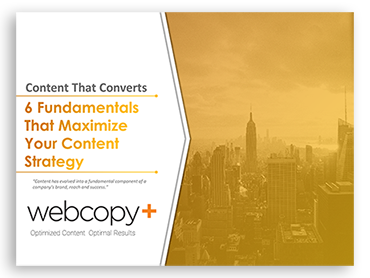What’s a web content strategy? It’s planning content creation, delivery and governance, and it’s a practice every business should employ — but few do. Taking a step back and developing the right strategy can maximize the impact and reach of your web content, and help you surpass your business goals.
Web Content Editor, Writer or Strategist?
Who can help you craft a winning content strategy? While you might be able to get to a certain point on your own, enlisting outside help brings you specific knowledge and experience, as well as a fresh perspective. A businesses owner who’s been grinding away for years only sees things a certain way. Meanwhile, the right questions coupled with well-thought-out guidance can bring new ideas, approaches and innovations to the table.
Content strategy is about more than just the written word. Therefore a content editor or writer can offer value provided he or she has the ability to evaluate business and customer needs, and map out strategic direction on how web content and processes can achieve specific objectives. If, for whatever reason, you must work with a content editor or writer without these abilities, it’s wise to bolster your team with a content strategist.
A well-versed content writer or strategist will help ensure your branding and marketing efforts feature content that’s purposeful, readable, understandable, findable, actionable and shareable across the Web.
Maximizing Content Impact
So how do you get your content to maximize results and help your business hit its goals?
1. Plan and Analyze
- Define your business goals and objectives. It’ll help you move in the right direction and allow you to measure progress.
- Be aware of your audience’s needs. Segment your audience into key groups (and personas) so you can speak more specifically to people’s needs and wants.
- Select the right distribution tools and channels. Consider everything from social media to traditional media.
- Look at ways to repurpose and cross-promote content. For instance, consider featuring top blog posts in newsletters, and extracting some snippets for Facebook and Twitter.
- Contemplate content formats. While articles can get great mileage, so can reports, videos, contests, surveys, press releases and infographics.
- Build a publishing calendar. This will help you plan time and resources, and ensure balls don’t get dropped.
2. Develop Winning Content
- It’s all about your customers. Let visitors find information relevant to their needs quickly, and complete tasks with ease.
- Aim to help. Genuinely try to help people and you’ll quickly build credibility and trust.
- Offer knowledge. Give value in advance and people will be more compelled to return the favour.
- Be a storyteller. Engage your audience with a meaningful story. In real estate marketing, for example, good storytelling sells a lifestyle, not just a home.
- Mind your standards. Produce quality content to separate yourself from others in your industry, get noticed and build a following.
- Inject passion. Authentic enthusiasm resonates with audiences. Demonstrate to people you genuinely want to help.
3. Manage and Measure
- Set and target goals. Benchmark your online presence, traffic, click-throughs, sales etc. against your goals, and also against your competitors where possible.
- Analyze and experiment. Use tools like Google Analytics to test content quality and effectiveness, and to gain insight through experimentation.
- Conduct audits. Your audiences desire relevant, accurate information. Give it to them. Also ensure other elements, like your structure, contact info and links are functional and up-to-date.
Create Content With Purpose
Building a content strategy forces you to focus. Every article and item you produce should serve a specific task.
Your approach to content planning and creation is worth the attention. You’ll gain traction and reach on and off the Web, and build your business to its full potential.







Writing content and creating a website without planning things is like getting in a car and driving blindly. You’re not going anywhere fast.
“Content that’s purposeful, readable, understandable, findable, actionable and shareable across the Web.” Easier said than done!!